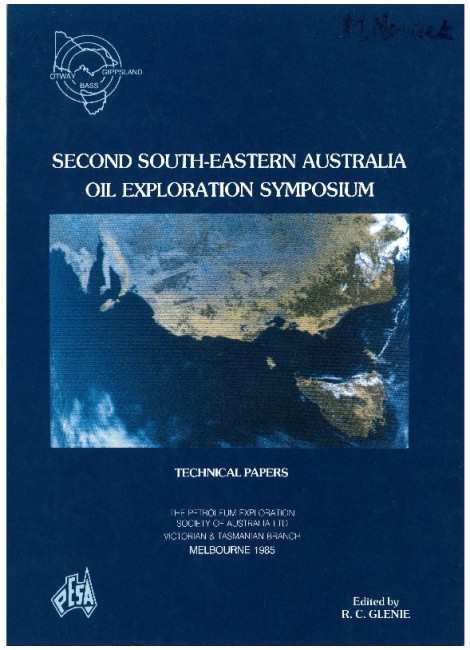Publication Name: Second South-Eastern Australia Oil Exploration Symposium - Technical Papers
Authors: G.R. Hodgate, G.H. Mackay and G.C. Smith
Date Published: December 1986
Number of Pages: 27
Reference Type: Book Section
Abstract:
The Portland Trough in the central Otway Basin contains over 2.5 km of Tertiary sediments (two-thirds Wangerrip Group, one-third Heytesbury-Nirranda Groups). They unconformably overlie a similarly thick but largely undrilled Upper Cretaceous sedimentary sequence (the Sherbrook Group), separated by an angular unconformity from the Lower Cretaceous Otway Group which forms effective tight basement. Most of the Portland Trough occurs onshore in the central area of the Otway Basin, and it has an axis trending west-northwest from Portland, ending near the State border.The Upper Cretaceous-Lower Tertiary comprises two major deltaic sequences. The Upper Cretaceous consists of thick prodelta shales (Belfast Mudstone), which thicken southwards into the Portland Trough and are overlain by interbedded sand-shale units (Curdies-Paaratte Formations) which represent delta slope and platform sediments and predominate to the north of the trough. This sequence is truncated by an angular unconformity with erosion of the section in the northern areas. The Lower Tertiary Wangerrip Group represents a second major deltaic sequence comprising a prodelta shale (Pember Mudstone) grading up through regionally correlative delta slope and platform cycles (Dilwyn Formation) into Middle Eocene marine shales (Burrungule Member). Transgressive Upper Eocene to Middle Miocene marine carbonates (Heytesbury- Nirranda Groups) unconformably overlie and truncate Wangerrip Group beds, particularly to the north and south of the trough.
In the western Otway Basin rapid burial occurred during the Early Cretaceous in the Otway Rift phase and during the Late Cretaceous in the initial Drift phase. Depositional rates waned in the Tertiary although local differential subsidence resulted in exceptionally rapid burial in the Portland Trough. The regional geothermal gradients are about 27-30?C/km which are average for young sedimentary basins, with lower gradients of 22-24?C/km occurring in the Portland Trough. The reflectance gradients also decrease into the axis of the Portland Trough, where Rvmax increases with depth from about 0.4% near the top of the Dilwyn Formation, to 0.8--0.9% at the base of the
Belfast Mudstone, and to higher estimated values within the Otway Group.
Four main organic matter facies are recognizable up through the sequence: (1) sparse inertinitic terrestrial
coaly matter in the Otway Group, (2) sparse marine and non-marine vitrinitic (minor inertinite-exinite) coaly matter in the Sherbrook Group and Pember Mudstone, (3) common non-marine and marginal marine vitrinitic (minor exinite) coaly matter in the Dilwyn Formation and Burrungule Member, (4) sparse marine calcareous organic matter in the Heytesbury- Nirranda Groups. The change in organic matter facies represents increasing generative potential from the Otway Group to the Sherbrook Group/Pember Mudstone to the Dilwyn Formation/Burrungule Member. However, given the rank distribution within the Portland Trough, the Sherbrook Group/Pember Mudstone represent the best source rocks being within their zone of oil generation. The Dilwyn Formation may be just within its initial zone of oil generation, the Otway Group is within its gas/condensate zone, and the Heytesbury-Nirranda Groups are immature.
Good potential reservoirs exist within the fluviodeltaic and marginal marine facies of the Sherbrook and Wangerrip Groups. The Otway Group contains few sandstones and most have low porosities and permeabilities resulting from their original volcanogenic composition and the effects of diagenesis and burial metamorphism. Numerous potential trap styles occur or are anticipated-including stratigraphic, unconformity and fault dependent traps, and those associated with minor compressional structures. Migration of hydrocarbons is expected to occur into the traps within the deep Portland Trough, or updip into traps on its flanks.


